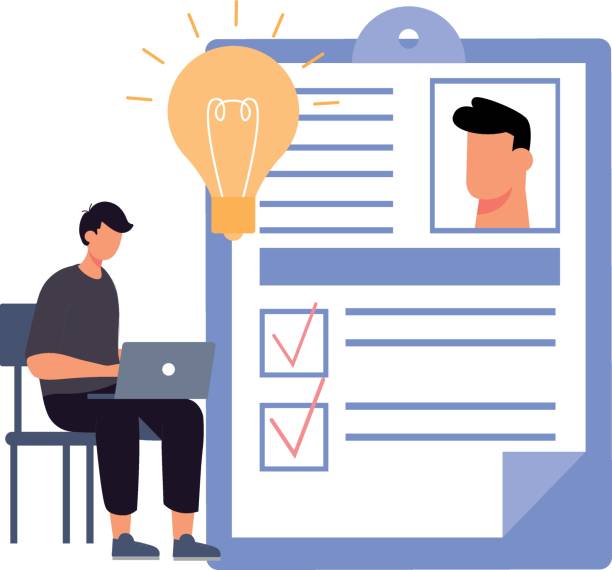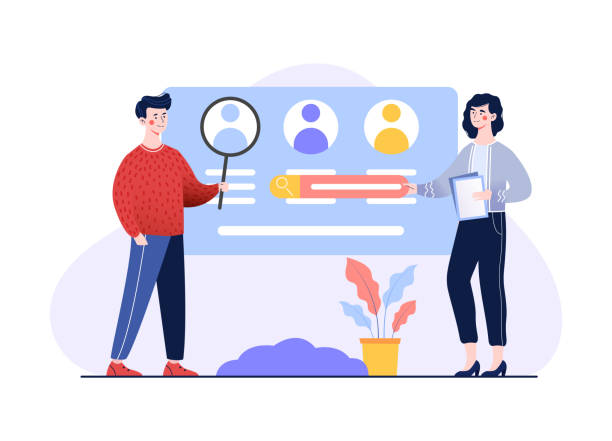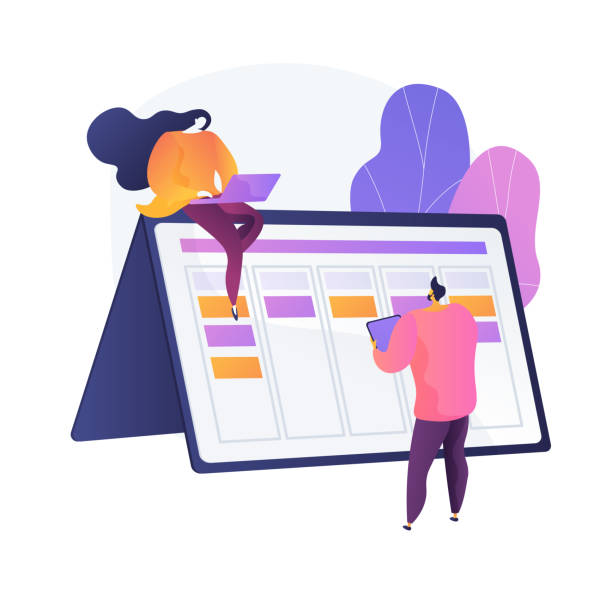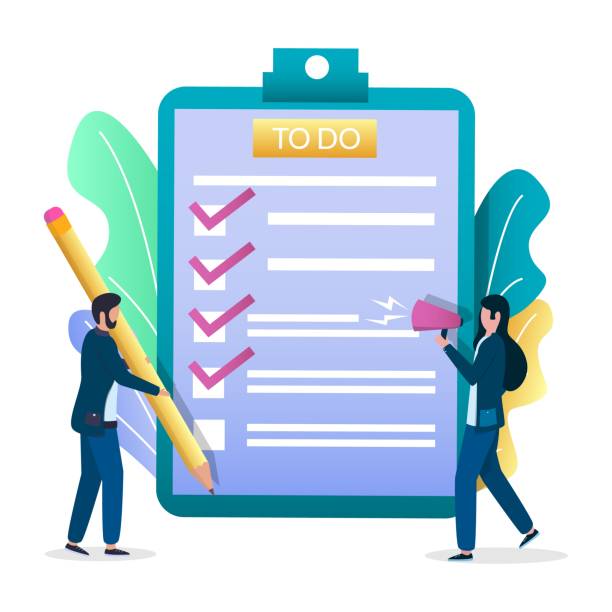Introduction to the Importance of Multilingual Website Design in the Global Era

In today’s world, where geographical boundaries have blurred in the digital space, multilingual website design is no longer a luxury choice, but a strategic necessity for any business aspiring to global expansion.
With the spread of the Internet, accessing audiences worldwide has become as simple as a click.
#Multilingual_website allows you to communicate with your users in their native language, which not only improves user experience but also builds a sense of trust and closeness.
This is especially crucial for companies offering their services or products in international markets.
Imagine having a website available only in Persian, while a significant portion of your potential customers live in other countries and speak other languages; in this case, you will lose countless opportunities.
A multilingual website opens a gateway to new markets and helps you elevate your digital marketing to a higher level.
This introductory approach will first show you why you should consider such a project and what opportunities await you.
Does your current corporate website not reflect your brand’s credibility and power as it should? Rasawap solves this challenge for you with professional corporate website design.
✅ Increase credibility and visitor trust
✅ Targeted attraction of more customers
⚡ Click for free consultation!
Numerous Benefits of Multilingual Website Design for Business Growth

By focusing on analyzing the benefits of multilingual website design, we can clearly see why this approach is vital for modern businesses.
One of the most important benefits is increased access to global audiences.
When your website is offered in multiple languages, you not only attract more traffic from different geographical regions but also increase your business’s potential to reach customers who were previously inaccessible.
This directly impacts your sales and revenue growth.
#Audience_growth Furthermore, improved #International_SEO (SEO) is another key advantage.
Search engines index multilingual websites better, especially when hreflang tags are used correctly.
This means higher rankings in search results for different keywords in different languages.
Beyond that, your customer trust and brand credibility are also strengthened.
Customers prefer to interact with websites whose content is provided in their native language.
This demonstrates respect for their culture and language and provides a better user experience.
Finally, having a multilingual platform differentiates you from other businesses and provides you with a significant competitive advantage.
This analytical section shows how this decision can strengthen the foundations of your success.
Technical Challenges and Solutions in Multilingual Website Design

When planning for multilingual website design, you will face numerous technical challenges that require precise solutions.
One of the main issues is #content_management in different languages.
This involves choosing a Content Management System (CMS) that supports robust multilingual capabilities.
WordPress with plugins like WPML or Polylang, Drupal, and Joomla are among the popular options that provide the necessary tools for organizing and translating content.
Another issue is the URL structure and how to manage domains or subdomains for each language.
Using subdirectories (e.g., yoursite.com/fa, yoursite.com/en), subdomains (fa.yoursite.com, en.yoursite.com), or top-level domains (yoursite.fa, yoursite.en) each have their own advantages and disadvantages that must be chosen based on your SEO goals and website’s technical structure.
#Technical_challenges Furthermore, supporting languages written from right-to-left (RTL), such as Persian and Arabic, requires responsive design and applying CSS changes for correct element orientation.
This #specialized section, by providing practical guidance, helps you successfully overcome these obstacles and create a strong infrastructure for your multilingual website.
The quality of coding and page load optimization for each language is also of high importance to provide an optimal user experience for all visitors.
A table comparing common technical solutions for language management is provided below.
| Solution | Advantages | Disadvantages | Suitable Application |
|---|---|---|---|
| Subdirectories (example.com/en) | Better SEO (main domain authority), easier management | Difficulty in switching between languages, complexity in large servers | Most websites, SEO-oriented |
| Subdomains (en.example.com) | Content separation, hosting on different servers | Requires separate SEO management for each subdomain | Large businesses with extensive and diverse content |
| Top-level domains (.fr, .de) | Strong localization, high local credibility | High cost, more complex management, requires purchasing separate domains | International companies with a strong presence in specific markets |
| URL parameters (example.com?lang=en) | Easy implementation | Weakest SEO option, unfriendly URLs | Small and temporary projects, where SEO is less important |
Choosing the Right Platform and Tools for Multilingual Website Design

For success in multilingual website design, choosing the right platform and tools is of paramount importance.
This decision should be made based on your business’s specific needs, available budget, and your team’s technical knowledge.
#Multilingual_platform One of the most common options is using Content Management Systems (CMS) like WordPress, which easily gains multilingual capabilities by installing powerful plugins such as WPML or Polylang.
These plugins allow for the translation of posts, pages, categories, and even navigation menus.
For larger and more complex websites, platforms like Drupal or Joomla are more suitable options, designed from the ground up for multilingual content management and offering high flexibility.
In addition to CMS, translation tools also play a significant role.
Using machine translation tools like Google Translate can be useful for a start, but for sensitive and specialized content, it is always recommended to use professional native localization translators to ensure accuracy and quality of translation.
This #educational section helps you make the best choice for the tools needed for your multilingual site development with full awareness and to make the best use of #web_translation_tools.
Don’t forget that technical support and continuous updates of the platform and plugins are also vital for maintaining the proper functioning of your website.
Does your company’s website perform as it should for your brand? In today’s competitive world, your website is your most important online tool. Rasawap, a specialist in professional corporate website design, helps you to:
✅ Gain credibility and customer trust
✅ Convert website visitors into customers
⚡ Get a free consultation!
Importance of International SEO in Multilingual Website Design

One of the main pillars of success in multilingual website design is #International_SEO.
Without adhering to international SEO principles, even the best translations cannot bring your website to global audiences.
Here, #search_engine_optimization for different languages comes into play.
The first step is #keyword_research in different languages.
Keywords that are common in one language may not have a similar meaning or be searched with different phrases in another language.
Therefore, it is necessary to conduct local keyword research for each language.
Another crucial point is the correct use of hreflang tags.
These tags inform search engines which version of the page for which language and geographical region is suitable.
This prevents the problem of duplicate content and ensures that users are directed to the correct language version of your website.
#Hreflang_tag Furthermore, a suitable URL structure (such as subdirectories or top-level domains) for each language sends stronger signals to search engines.
In addition, optimizing content for each language, including translated #metadata, meta descriptions, and page titles, is very important for improving ranking.
This #specialized section helps you ensure your website’s global visibility in search engines and fully leverage the potential of multilingual website design by observing these key points.
This is a complex process that requires precision and technical knowledge.
User Experience and Content Localization in Multilingual Websites

Beyond mere text translation, multilingual website design requires deep attention to #User_Experience (UX) and #content_localization.
This means adapting content and user interface to the culture, customs, and expectations of audiences in each geographical region.
For example, colors, images, and even symbols can have different meanings in different cultures.
Therefore, careful selection of visual elements for each language version of your website is crucial.
#Cultural_localization Also, attention should be paid to the formatting of numbers, dates, currency, and measurement systems to comply with local standards.
Even the tone and writing style of the content should be adjusted to suit the local audience.
#Entertaining and #educational content can be more impactful if it aligns with local culture and interests.
For example, a joke or idiom in one language might be meaningless or even offensive in another.
Providing clear options for language switching on the website, such as a dropdown menu or small flags, is also very important for improving UX.
#Language_switch Users should be able to easily switch between different languages.
This #educational section shows you how, by focusing on cultural details, you can provide an unparalleled user experience for visitors from around the world and establish a deeper connection with them, which contributes to the even greater success of your multilingual site project.
Content Management and Translation Process in Multilingual Website Design

Content management and the translation process are among the most important aspects in multilingual website design, requiring a comprehensive #guide.
After choosing the right platform, you need to define an efficient #translation_workflow.
This process typically includes content extraction, sending to translators, review, and finally re-uploading the translated content to the website.
Translation Management Tools (TMS) such as Phrase, Smartling, or Transifex can significantly simplify and streamline this process.
These tools enable managing translation projects, collaboration between translators and reviewers, and even using Translation Memory and Termbase to ensure consistency and quality of translations over time.
#Translation_Memory The differences between machine translation and #human_translation should not be overlooked.
While machine translation can be useful for large volumes of content or initial drafts, for sensitive, marketing, or legal content, the use of native-speaking and expert translators is essential.
This #specialized section, by providing a deep dive into the processes of #multilingual_content_management, helps you implement the best practices for maintaining and updating your website in multiple languages.
Multilingual website development requires continuous attention to these details to always provide accurate and up-to-date content.
The table below provides a comparison of the main translation methods.
| Translation Type | Advantages | Disadvantages | Suitable Application |
|---|---|---|---|
| Human Translation (Professional) | High accuracy, cultural localization, natural language quality, SEO friendly | High cost, time-consuming | Marketing, legal, specialized content, main website pages |
| Machine Translation (MT) | High speed, low cost, suitable for large volumes of content | Inaccuracy, lack of localization, low quality, requires human editing (Post-editing) | Internal content, customer support, non-sensitive blog articles |
| Machine Translation with Post-editing (MTPE) | Medium speed and cost, improved quality compared to pure MT | May still not be as complete as human translation | Medium volume content with limited budget, technical content |
| Crowdsourcing Translation | Lower cost, community participation | Difficult quality control, time-consuming, requires strong management | Non-profit projects, open-source software, communities |
Legal and Privacy Aspects in Multilingual Websites

When #designing a multilingual website, paying attention to legal aspects and privacy in different geographical regions is of high importance.
Data and privacy regulations can vary significantly across countries.
For example, the General Data Protection Regulation (GDPR) in the European Union imposes strict requirements for collecting, storing, and processing personal data.
#GDPR_and_multilingual_website Your website must have a #privacy_policy and #terms_and_conditions that are translated and accessible in all languages your website supports.
These documents must clearly explain how user information is collected, used, and protected.
You must also ensure compliance with local laws regarding cookies, user consent, and other local regulations.
#Cookies_and_user_consent Some countries may have specific laws regarding permitted or prohibited content that must be considered when localizing content.
Ignoring these issues can lead to heavy fines or even legal problems.
This #news and #explanatory section advises you to consult with legal experts before launching the multilingual version of your website to ensure full compliance with local laws.
Commitment to transparency and user data protection is not only a legal requirement but also helps build trust with your audience worldwide and shows that you care about their security and privacy.
Did you know that a weak corporate website loses you many opportunities daily? Solve this problem forever with professional corporate website design by Rasawap!
✅ Create a powerful and reliable image of your brand
✅ Attract new customers targetedly and increase sales
⚡ [Get free website design consultation]
Successful Multilingual Websites: Examples and Lessons

Looking at #successful_multilingual_websites can be inspiring and provide valuable lessons for your multilingual website design.
Large companies like Google, Amazon, or Airbnb are prime examples of websites that are well-localized and provide a seamless user experience across different languages and cultures.
Their secret to success is not just in translating texts, but in a deep understanding of local needs and preferences.
For example, Airbnb not only changes the website’s language but also displays prices in local currency and provides common payment options in each country.
#Airbnb_multilingual These companies engage in #global_market_analysis and implementation of extensive localization strategies that include textual, visual, and even cultural content.
The lesson to be learned from these examples is that #global_success is achieved through a comprehensive approach to multilingual website design.
This #entertaining yet #analytical section shows you how, by focusing on user needs and providing a fully localized experience, you can turn your website into a powerful tool for global expansion.
Ignoring local culture and preferences can easily lead to failure, while investing in true localization will bring significant results and pave the way for your multilingual website expansion.
The Future of Multilingual Website Design and New Trends

The future of multilingual website design is rapidly evolving, with new trends emerging that need attention.
One of the most important trends is the significant advancements in #Artificial_Intelligence and #Neural_Machine_Translation (NMT).
These technologies are capable of providing translations with quality very close to human translation and can accelerate and cheapen the localization process.
It is expected that in the near future, instant and real-time translation on websites will become a standard.
#AI_in_translation Also, with the increasing popularity of #voice_search, multilingual websites must prepare to respond to voice queries in different languages.
This means optimizing content for spoken language and using #conversational_keywords.
#Multilingual_voice_search Beyond this, the emergence of Virtual Reality (VR) and Augmented Reality (AR) technologies can also have a profound impact on how users interact with multilingual content.
Imagine visitors being able to walk through a virtual multilingual store and hear product descriptions in their preferred language.
This #thought-provoking and #news section, by posing questions about the future and upcoming developments, helps you gain insight into new horizons in multilingual website optimization.
By following these trends and investing in emerging technologies, businesses can prepare themselves to compete in a rapidly changing global market and fully leverage the potential of their multilingual website.
Frequently Asked Questions
| No. | Question | Answer |
|---|---|---|
| 1 | What is multilingual website design? | Multilingual website design means building a website whose content is available to users in several different languages. This is usually done through a simple user interface for changing the language. |
| 2 | Why should we design a multilingual website? | Designing a multilingual website helps you reach more audiences worldwide, provide a better user experience for international users, and improve your global SEO. |
| 3 | What are the main methods for implementing multilingualism on a website? | The main methods include using subdomains, subdirectories, or URL parameters for each language, as well as using completely separate domains for each language. |
| 4 | Is it better for SEO to use subdirectories or subdomains? | In terms of SEO, both subdirectory and subdomain methods can be effective. However, many SEO experts prefer subdirectories due to better transfer of main domain authority. |
| 5 | What are the important points in translating multilingual website content? | Translation should be done by native translators, content should be localized (localization) in addition to translation to match the target audience’s culture, and pure machine translation should be avoided. |
| 6 | What is the role of the hreflang tag in multilingual website SEO? | The hreflang tag helps search engines like Google display the correct language and regional version of a page to appropriate users, which also prevents duplicate content issues. |
| 7 | Is it possible to make a website multilingual without coding? | Yes, in Content Management Systems (CMS) like WordPress, there are powerful plugins such as WPML or Polylang that enable making a website multilingual without needing to code. |
| 8 | What are the challenges of multilingual website design? | Challenges include translation management, content localization, adhering to SEO principles for each language, technical support for different languages, and ensuring design consistency across different languages. |
| 9 | What is the difference between translation and localization? | Translation is merely converting words from one language to another, while localization involves adapting content to the culture, customs, currency, date and time formats, and even appropriate colors for the target audience. |
| 10 | What is the best User Experience (UX) for language switching? | A clear and accessible language switch (usually in the header or footer), using the language name instead of flags (due to regional diversity), and maintaining the user’s position after changing the language are important UX points. |
And other services of Rasa Web advertising agency in the field of advertising
Intelligent Conversion Rate Optimization: A dedicated service for growth in website traffic based on custom programming.
Smart Digital Advertising: Professional optimization for campaign management using custom programming.
Smart Website Development: A combination of creativity and technology for digital branding through precise audience targeting.
Smart Website Development: A combination of creativity and technology for user interaction through SEO-driven content strategy.
Smart Marketplace: An effective tool to improve SEO ranking with the help of Google Ads management.
And over hundreds of other services in the field of internet advertising, advertising consultation, and organizational solutions
Internet Advertising | Advertising Strategy | Advertorial
Resources
Comprehensive Guide to Multilingual Website Design
Multilingual Website SEO
Importance of Multilingual Site
What is a Multilingual Site?
? Are you ready to transform your business in the digital world? Rasaweb Afarin Digital Marketing Agency, by providing professional services including WordPress website design and SEO optimization, paves the way for your online success. Build a bright future for your brand with us.
📍 Tehran, Mirdamad Street, next to Central Bank, Southern Kazeroun Alley, Ramin Alley, No. 6


